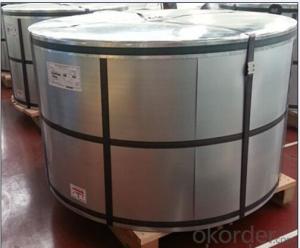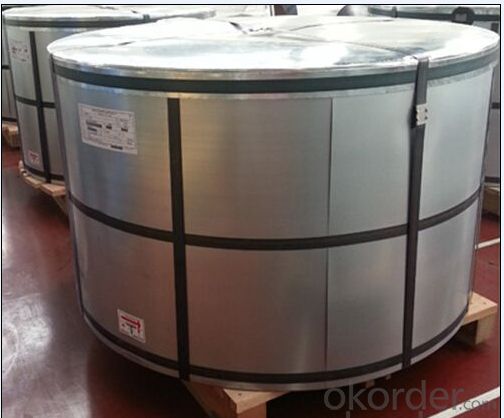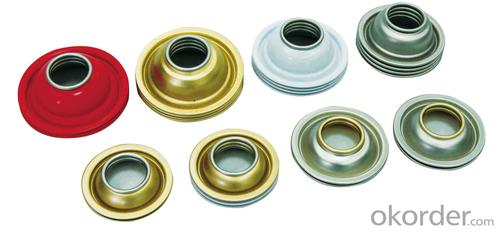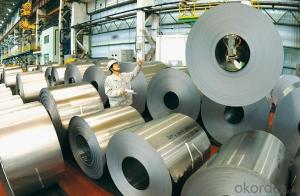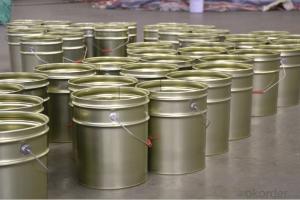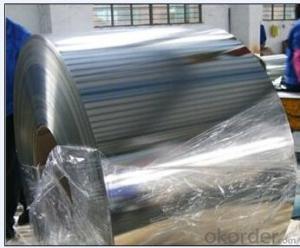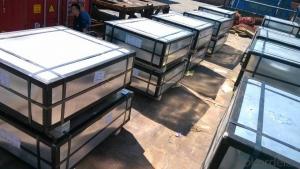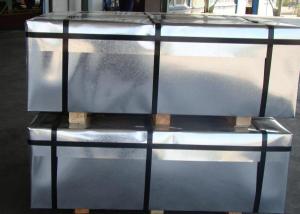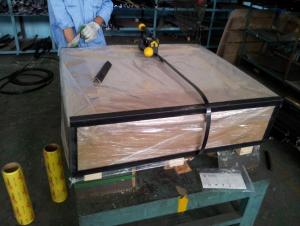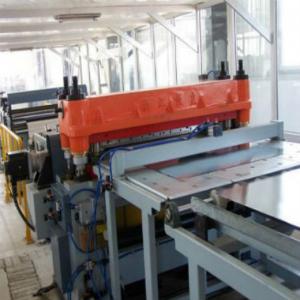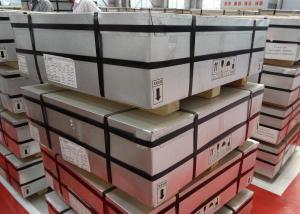Tinplate Manufacture For Biscuits Cans, MR/SPCC Material
- Loading Port:
- China main port
- Payment Terms:
- TT OR LC
- Min Order Qty:
- 25 m.t.
- Supply Capability:
- 40000 m.t./month
OKorder Service Pledge
OKorder Financial Service
You Might Also Like
1.Brief Introduction
Tinplate is widely used for making all types of containers, containing industrial usage such as paint can, oil can, aerosol cans etc., and food cans like milk powder cans, tomato paste can, dry food cans etc.
2. Quality
As a state owned company and a large tinplate supplier in China, our tinplate quality ranks 1st level in China, similar to Bao Steel, Posco etc.
3. Specification
standard: GB/T2520, JIS G3303, DIN EN10202
Material: MR /SPCC
Thickness available: 0.16-0.50MM
Width available: 600~1050MM
Temper grade: T1 – DR8
Tin coating: ordinary 2.8g/2.8g, 5.6g/5.6g and others
Package: sea worthy export package.
Applications: Tin can for chemicals & paint cans, industrial cans, food cans
4. Our production steps
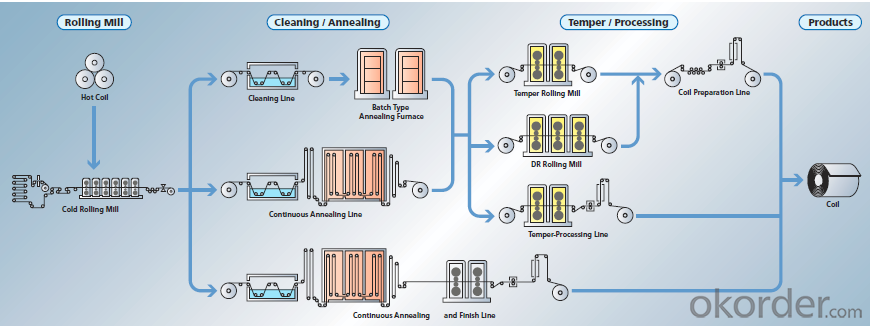
5. Usage Scope
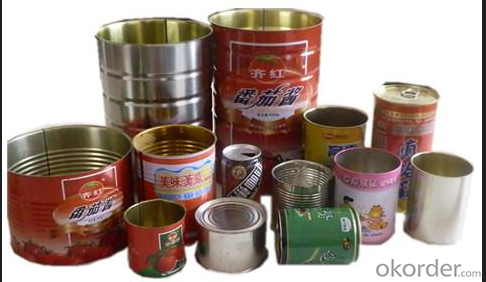
6. Our euxport market
our tinplate has been popularly exported to more than 30 countries, including Asia, Europe countries, Gulf area, Sounth America, Northe & South Africa etc.
7. FAQ
a. what's the annual output?
about 500,000 tons per year.
b. where's the raw matrial from?
our hot rolled coil is purchased from Capital Steel and other state owned mill, with quite good quality.
c. how long is the delivery time?
normally for SPCC about 45~55 days, while 65~75 days for MR material
d. how to control the quality during production process?
inside our workshop, we have MES syestem. It realizes the optimization of the production procedure in the workshop. It could record each step of the whole production procedures, and if some problem appears, factory could easily found and take action, it’s quite helpful to monitor and control the quality.
- Q: What are the main regulations governing tinplate production?
- The main regulations governing tinplate production include health and safety standards, environmental regulations, quality control measures, and labeling requirements. These regulations ensure that tinplate production processes are conducted safely, with minimal impact on the environment, and that the final product meets quality standards. Additionally, labeling requirements ensure that tinplate products are accurately labeled and provide necessary information to consumers.
- Q: How does tinplate compare to tin-free steel in terms of properties and applications?
- Tinplate and tin-free steel differ in terms of properties and applications. Tinplate has a thin tin coating on its surface, providing excellent corrosion resistance and a shiny appearance. It is commonly used in food and beverage packaging, as well as for decorative purposes. On the other hand, tin-free steel lacks the tin coating and is typically coated with other materials like chromium or polymer. It offers better paint adhesion and is often used in applications such as automotive parts, electrical appliances, and construction materials. Therefore, the choice between tinplate and tin-free steel depends on the specific requirements and intended applications.
- Q: How does tinplate packaging contribute to product convenience?
- Tinplate packaging contributes to product convenience by providing a durable and lightweight solution that ensures the preservation and protection of the contents. Additionally, its easy-to-open feature, resealable options, and ability to be easily transported make it a convenient choice for consumers.
- Q: Can tinplate packaging be used for non-food items?
- Yes, tinplate packaging can be used for non-food items as well. It is a versatile material that offers durability and protection, making it suitable for packaging various non-food products such as cosmetics, pharmaceuticals, and household goods. Tinplate packaging helps ensure product integrity and enhances the overall appeal while providing a sustainable and recyclable option.
- Q: Is to buy canned tinplate or aluminum
- Tinned food is usually made of tinplate, because the strength of tin is higher than that of aluminum cans, and the tin can not be deflatedAluminium is generally used in carbonated beveragesTin can be best served from the point of view of transport
- Q: How does tinplate perform in terms of temperature resistance?
- Tinplate performs well in terms of temperature resistance, as it can withstand high temperatures without losing its structural integrity or experiencing significant changes in its physical properties.
- Q: How does tinplate contribute to food safety?
- Tinplate contributes to food safety by providing a protective barrier between the food and the metal surface, preventing the transfer of any harmful substances or contaminants. Additionally, tinplate helps to preserve the quality and freshness of the food by preventing exposure to air, moisture, and light, which can lead to spoilage.
- Q: How does the printing process affect the durability of tinplate?
- The printing process can have both positive and negative effects on the durability of tinplate. On one hand, the application of a protective coating during the printing process can enhance the tinplate's resistance to corrosion, scratches, and other forms of damage. This can significantly improve its overall durability. On the other hand, if the printing process is not done properly or if low-quality inks or coatings are used, it can weaken the tinplate's protective layer, making it more prone to wear and tear. Therefore, the printing process plays a crucial role in determining the durability of tinplate.
- Q: Can tinplate be used for packaging products with sensitive electronic components?
- Yes, tinplate can be used for packaging products with sensitive electronic components. Tinplate is known for its excellent electrical conductivity and corrosion resistance, making it an ideal choice for protecting sensitive electronic components from external factors such as moisture and oxidation. Additionally, tinplate offers good mechanical strength and can be easily formed into various shapes, providing secure packaging for these components.
- Q: How does tinplate affect the overall branding of products?
- Tinplate can significantly impact the overall branding of products as it offers various advantages. Its sleek and glossy appearance adds a premium and sophisticated touch to the packaging, enhancing the perceived value of the product. Additionally, tinplate provides excellent protection against moisture, light, and oxygen, ensuring the quality and freshness of the contents. This durability and protective feature associated with tinplate packaging help to build trust and credibility among consumers, reinforcing the brand image. Furthermore, tinplate's versatility allows for unique and eye-catching designs, facilitating differentiation and attracting consumers' attention on store shelves. Overall, tinplate plays a crucial role in elevating the branding of products, creating a memorable and positive consumer experience.
Send your message to us
Tinplate Manufacture For Biscuits Cans, MR/SPCC Material
- Loading Port:
- China main port
- Payment Terms:
- TT OR LC
- Min Order Qty:
- 25 m.t.
- Supply Capability:
- 40000 m.t./month
OKorder Service Pledge
OKorder Financial Service
Similar products
Hot products
Hot Searches
Related keywords
